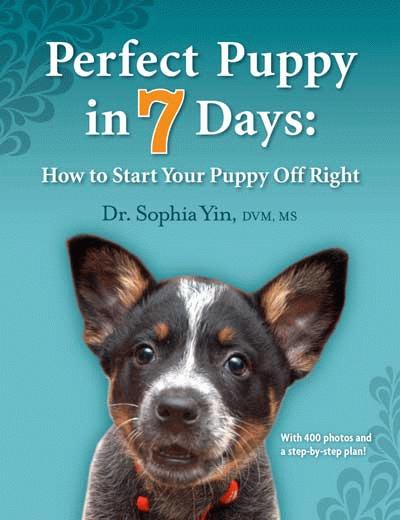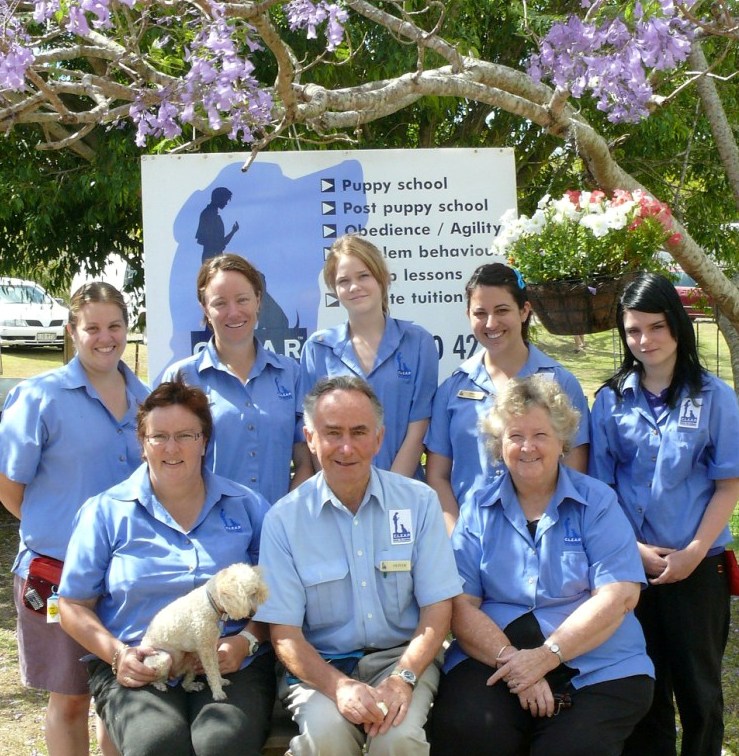Puppy School Brisbane
Around the Western world puppy schools are these days being run at dog clubs, animal shelters, dog training schools and increasingly at many vet surgeries and pet stores.
Going to a good puppy school is one of the best things that can happen to any puppy, going to a bad one is one of the very worst things that can happen to it.
At C.L.E.A.R Dog Training's Unique Sunday Puppy School October 2009
Emma, Sarah, Georgia, Rosina, Katie,Maria, Oliver, Rose
Taking an 8-14 week old puppy to a well run puppy class, where puppies are of the same age and size and have adeqate space between them, can give him a head start to life.
However classes that are being conducted by inexperienced people with inadequate qualifications, skills and knowledge is a recipe for future behaviour problems.
So, rather than letting your puppy be practised on by such people, which could mess him up and cause a great deal of long term harm, be prepared to travel further than the nearest dog school, pet store or veterinary clinic.
In the same way that parents check out and compare various day care centres and kindgergartens before deciding where to send their children responsible dog owners do the same thing with their puppies.
If they can not locate a really good* puppy school then they make suitable alternative arrangements such as in-home puppy socialisation, habituation and junior obedience.
CLEAR Dog Training used to run unique group puppy classes around Brisbane for 12 years, to which people including vets and breeders and other dog trainers with their own dogs came from as far away as Buderim, Ipswich and the Gold Coast. However, nowadays we specialise solely in private in-home puppy training.

Many of our clients in the period 2001-2014 have opted for this method of education for their puppies [and often, just as importantly, for themselves] either before, instead of or after attending puppy school. We provide unique tuition, guidance, recommendations and resources; as a result of which they are knowledgeable owners with dogs that are ideal family pets – obedient, calm and controlled, well mannered and able to be taken anywhere.

If you think your puppy would benefit from attending group classes - either before, instead of or after attending puppy school - this article by Oliver Beverly, which was published in the the newsletter of the Association of Pet Dog Trainers Australia's in November 2006, will help you decide where best to go.
* 'What to Look For In a Good Puppy School?'
1. Is the person who answers the telephone or greets people at the counter of the pet store, dog club, training school or vet surgery - knowledgeable, friendly, interested and caring? (If the replies are vague, evasive or inadequate score zero out of twenty. Persevere but begin thinking of alternatives. Score ouf of 20? (--/20)
2. Who takes the puppy classes? Do they have an excellent reputation? Do they have good communication and people skills? How widespread is their experience and what are their areas of expertise? Do they listen to the owner’s needs and expectations? Do they find out pertinent details about the puppy’s background and lifestyle prior to the beginning of the first class? Are they welcoming? Do they have a sense of humour? Can they control a class fairly and impartially? Do they keep in touch and follow up throughout the course and after it has finished? (--/20)
3. What are their qualifications? How experienced are they at running well attended puppy classes? Are they interesting and able to keep people’s attention? Are they knowledgeable about all aspects of canine development and many different breeds? Have they raised a puppy or bred a litter of puppies? Do they have a genuine love of and affection for dogs? Score ten if they are a Level lV vet nurse with additional accredited qualifications in behavioural dog training or a similarly qualified breeder or experienced trainer using gentle modern training methods. Score zero if they are an inexperienced vet clinic receptionist, a junior instructor at a dog club or a salesperson at a pet store. They may never have owned a dog and know only a little more than the average first time pet owner. Don’t let them practice on your puppy! (--/20)
4. How many puppies are there per instructor? Are the classes too big - more than eight - or too small - less than four? Does the instructor have an assistant? Are the assistants well-informed, friendly and helpful? Do they wear appropriate clothing and footwear for dog training? Are they in uniform? Do they look professional? (--/20)
5. How and when do puppy to puppy interactions occur? At the beginning of each class or later on and only as a result of calm behaviour? Is the first item on the agenda a general (and often disastrous) free for all socialisation with all puppies playing together? Are barriers or play pens used to separate the puppies? How many puppies are allowed to play with each other at any one time? What happens if one of the puppies is a bully? What allowances are made for shy puppies? Is puppy play frequently interrupted with the puppy coming back to the owner? (--/20)
6. Are the puppies calm and settled and stress free throughout the class? Are the owners alert and interested? Are they all puppies and people having fun and happy to be there? (--/10)
7. Is it possible and is it easy to observe a puppy class in order to observe first hand before deciding to attend it? (If the answer is negative, for any reason - e.g. lack of space, not wanting other people to copy their methods or ideas! score zero. (--/10)
8. Where are the classes held? Church hall, school gymnasium, basket ball court, sports field changing rooms, vets waiting room, vets car park, groomers parlour, pet store warehouse, industrial shed or, if in the tropics, on the beach under a coconut palm? Are the premises, whether indoors or outdoors or a combination of both, clean and safe for puppies? Is there adequate space, of at least three meters, between puppies or are they crammed into a small waiting room? What are the various surfaces that the puppy will be able to experience tiles, concrete, carpet, rubber, sand, grass? Does the class setting provide a welcoming and good environment for learning? Is it free of interruptions? (--/10)
9. When does the next course start? Is it a fixed week class or a flexi week one? Are there too many puppies, people and children in a small room at the same time? What happens if there are not enough puppies for the class to be held? Are people put on a waiting list till there are sufficient numbers? By then it is often too late and the puppy is too old and misses out, so what contingency plans are there to immediately refer them to an associate/colleague or competitor elsewhere? Do they run follow on courses? If not do they provide a list of suitable places using modern training methods where their puppy school graduates can go? (--/10)
10. What happens if the owner or the puppy is ill and can’t come to one or more of the classes? What happens if the instructor is ill and can’t come? What make-up class, wet weather or refund policies are in place? (--/10)
11. How is the course structured? Is there a syllabus available with course content? Are well constructed lesson plans utilized? What training aids or props are used to teach new concepts? Are weekly home training sheets provided with specific suggestions and exercises to do at home? (--/10)
12. When do owners have an opportunity to ask questions? How well are they answered? Can owners easily contact the instructor between classes? Is additional information provided to owners during the week by letter, fax or e-mail? (--/10)
13. Are training aids available? Is there a supply of essential items - for instance blue puppy Kongs, car harnesses, treats and really good puppy books such as “After You Get Your Puppy” or “The Ultimate Puppy Tool Kit”? (--/10)
14. What learning materials are provided or loaned out? A puppy manual? Brochures? Puppy class handouts from a veterinary behaviourist such as those produced by APDT Australia member Dr Debbie Calnon or The First Twelve Months CD produced by Dr Cam Day? Other CDs or DVDs on puppy development? Loan booklets, such as Terry Ryan’s Take the L.E.A.D. or Puppy Primer? (--/10)
15. What do previous owners who have attended puppy classes have to say about their experience at this venue? Are exit survey forms used and available for inspection? Can previous owners be contacted to see how their puppy progressed? Did they enjoy coming? Do they recommend the puppy class to their friends as being good value for money? Would they come again themselves with their next puppy? (--/10)
Scores:
If the score is less than 125 out of 200, don't go and keep looking!
A score of 125 - 170 suggests that, if there is no better alternative, it may be worthwhile attending but that there is room for improvement in many key areas.
A score of 170 + indicates that the puppy school is definitely on the right track but needs to keep on fine tuning its operations via, say, customer exit survey forms.
Most of the questions to ask when selecting a suitable puppy school are answered by simply watching several classes beforehand and making notes. If that is not practical the next best thing is talking to several people who have been there about their impressions and recommendations.
This article by Oliver Beverly, owner of and chief instructor at C.L.E.A.R Dog Training, was published in the October - November 2006 Newsletter of the Association of Pet Dog Trainers Australia
Click HERE for essential Training Tip # 3: 'How compulsion and coercion interfere with learning'



